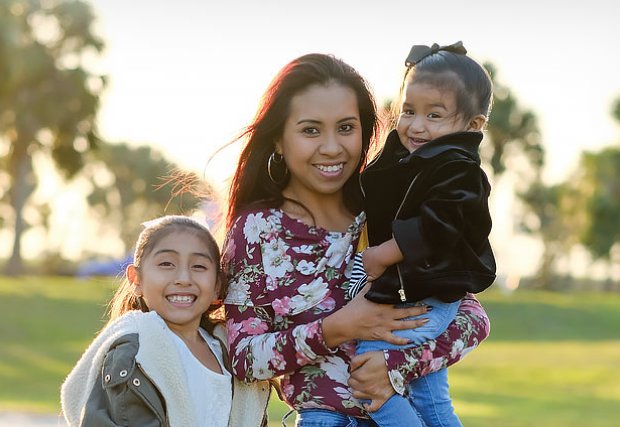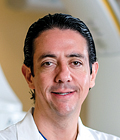Jessica Serrano and her girls enjoy a day out.
Jessica Serrano left work early one day last May to take her seven-year old daughter to an appointment, and nothing was out of the ordinary. “I was fine the whole day,” she says. She was filling out paperwork, and her right arm felt heavy. “I tried to raise my hand and it kept falling,” she says. “My daughter noticed my mouth was tilted to the side and I was talking funny. The moment I stood up to get help, I collapsed.”
In the ambulance, she reassured her daughter that everything was going to be okay, as paramedics took her to Wellington Regional Medical Center’s Comprehensive Stroke Center. When she arrived, neurointerventionalist Juan Gomez, MD, explained that she had a stroke and needed surgery right away.
As the nursing staff comforted her daughter and arranged to have her 18-month-old baby picked up at daycare, Dr. Gomez performed a minimally invasive procedure, called a thrombectomy, to remove blood clots from the right side of her brain. The procedure involved making a small incision in the groin and feeding a catheter up through the artery to the site of the clot, explains Alice Cruikshank, RN, MSN, CNRN, stroke program coordinator. A retrieval device was then passed through the catheter and used to pull the clot out and restore blood flow to the brain.
Serrano spent five days in the hospital. The hospital staff were “awesome,” she says, recalling how they were always there for her and helped her get back to walking normally by the fourth day. “I actually went back to the normal me really quickly,” she says. “I have no side effects or disabilities.”
“Dr. Gomez explained that the paramedics arrived at the perfect time,” she adds.
“I would have been paralyzed on my left side if I didn’t get treatment when I did.”
She notes that she experienced similar but less severe symptoms several years earlier, but they went away on their own and she never found out what caused them. “It was a shock,” she says of having a stroke at just 24 years old. “Some people think stroke is an
older person’s disease, but it isn’t,” says Cruikshank. “It doesn’t discriminate against age.” It’s important for people to recognize the warning signs and call 911 right away if they think they may be having a possible stroke.
Today Serrano takes precautions, especially when driving. “If I feel any part of my body heavy or tingling, I am concerned that it could be a sign of stroke,” she explains. “In case I were to experience those symptoms again, I know what to do, and my daughter knows to call 911.”
“The advice I have is that if you don’t feel comfortable within your body and feel like something is weird, don’t ignore it,” she adds. “Ask for help before it goes any further.”
She is now back to her usual routine and spends as much time as she can with her family and her daughters. “It was like a new beginning for me,” she says. “It’s a miracle that I’m back to normal.”
Do You Know the Symptoms of a Possible Stroke?
Recognizing the symptoms can help save your life or someone else's life. Just think F.A.S.T.
Face: Ask the person to smile. Does one side of the face droop?
Arms: Ask the person to raise both arms. Does one arm drift downward?
Speech: Ask the person to repeat a simple phrase. Is it slurred or strange?
Time: is critical! If you see any of these signs, call 9-1-1 immediately.
If these symptoms appear, DON'T WAIT! Call 9-1-1 immediately. The sooner you get help, the better your chances for a good outcome.


